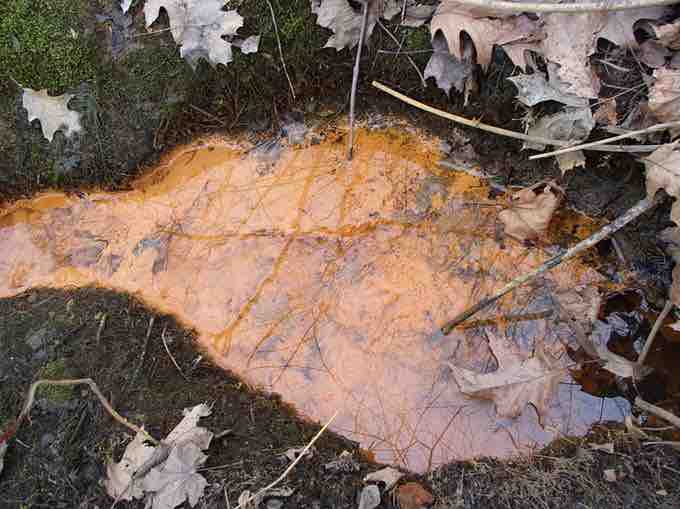Ferric iron (Fe3+) is a widespread anaerobic terminal electron acceptor both for autotrophic and heterotrophic organisms. Electron flow in these organisms is similar to those in electron transport, ending in oxygen or nitrate, except that in ferric iron-reducing organisms the final enzyme in this system is a ferric iron reductase. Model organisms include Shewanella putrefaciens and Geobacter metallireducens. Since some ferric iron-reducing bacteria (e.g. G. metallireducens) can use toxic hydrocarbons such as toluene as a carbon source, there is significant interest in using these organisms as bioremediation agents in ferric iron-rich contaminated aquifers .

Iron Bacteria
Common effects of excess iron in water are a reddish-brown color and stained laundry. Iron bacteria are a natural part of the environment in most parts of the world. These microorganisms combine dissolved iron or manganese with oxygen and use it to form rust-colored deposits. In the process, the bacteria produce a brown slime that builds up on well screens, pipes, and plumbing fixtures. Bacteria known to feed on iron are Thiobacillus ferrooxidans and Leptospirillum ferrooxidans.
Ferrous iron is a soluble form of iron that is stable at extremely low pHs or under anaerobic conditions. Under aerobic, moderate pH conditions ferrous iron is oxidized spontaneously to the ferric (Fe3+) form and is hydrolyzed abiotically to insoluble ferric hydroxide (Fe(OH)3). There are three distinct types of ferrous iron-oxidizing microbes. The first are acidophiles, such as the bacteria Acidithiobacillus ferrooxidans and Leptospirillum ferrooxidans, as well as the archaeon Ferroplasma. These microbes oxidize iron in environments that have a very low pH and are important in acid mine drainage. The second type of microbes oxidizes ferrous iron at cirum-neutral pH. These micro-organisms (for example Gallionella ferruginea or Leptothrix ochracea) live at the oxic-anoxic interfaces and are microaerophiles. The third type of iron-oxidizing microbes is anaerobic photosynthetic bacteria such as Rhodopseudomonas, which use ferrous iron to produce NADH for autotrophic carbon dioxide fixation. Biochemically, aerobic iron oxidation is a very energetically poor process which therefore requires large amounts of iron to be oxidized by the enzyme rusticyanin to facilitate the formation of proton motive force. Like sulfur oxidation, reverse electron flow must be used to form the NADH used for carbon dioxide fixation via the Calvin cycle.
Although ferric iron is the most prevalent inorganic electron acceptor, a number of organisms (including the iron-reducing bacteria mentioned above) can use other inorganic ions in anaerobic respiration. While these processes may often be less significant ecologically, they are of considerable interest for bioremediation, especially when heavy metals or radionuclides are used as electron acceptors. Examples include:
- Manganic ion (Mn4+) reduction to manganous ion]] (Mn2+)
- Selenate (SeO2−4) reduction to selenite (SeO2−3) and selenite reduction to inorganic selenium (Se0)
- Arsenate (AsO3−4) reduction to arsenite (AsO3−3)
- Uranyl ion ion (UO2+2) reduction to uranium dioxide (UO2)